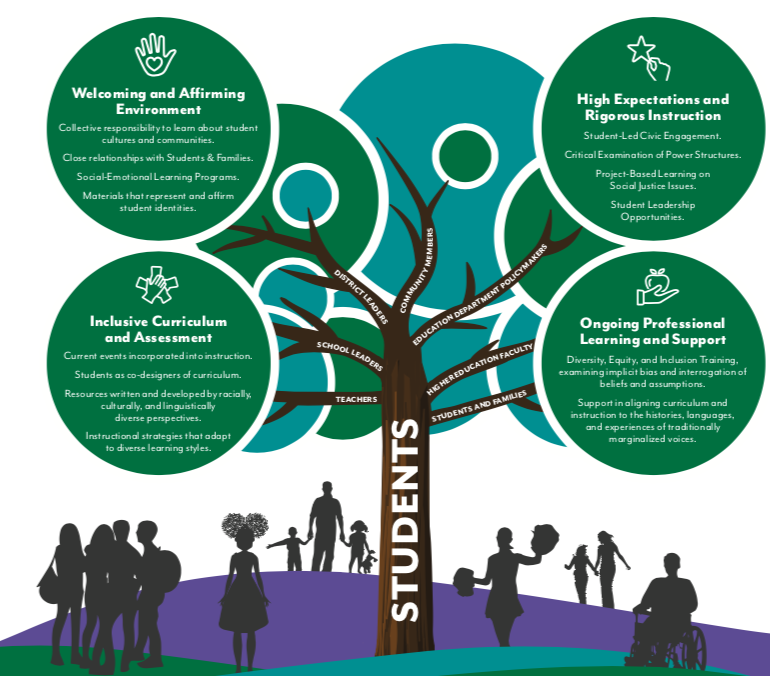Objective: To define culturally responsive-sustaining education using 3 key aspects: partnerships, high expectations, and student-driven instruction.

The information below is taken from NYSED Culturally Responsive-Sustaining Education Framework.
The Culturally Responsive-Sustaining (CR-S) framework is intended to help education stakeholders create student-centered learning environments that affirm cultural identities; foster positive academic outcomes; develop students’ abilities to connect across lines of difference; elevate historically marginalized voices;
This vision is grounded in Gloria Ladson-Billings’ early work on culturally relevant teaching, specifically the three criteria for culturally relevant pedagogy she puts forth in Ladson-Billings (1995). The New York State Culturally Responsive-Sustaining Framework includes guidelines for students, teachers, school leaders, district leaders, families and community members, higher education faculty, and Education Department policymakers. For guidelines to be effective, all stakeholders must work together, prioritize and implement systems and structures that facilitate the scale of culturally responsive-sustaining practices, and hold each other accountable to short- and long-term goals.
When stakeholders work together to implement culturally responsive-sustaining practices, educators will grow in their ability to be:
Sociopolitically Conscious
- Demonstrate excellence by being inclusive-minded and asset-focused
- Identify and critically examine both historical and contemporary power structures
- Reflect, honor, value, and center various identity perspectives as assets in policies and practices (Sue, 2001)
- Engage in critical conversations
- Recognize that personal, cultural, and institutionalized discrimination creates and sustains privileges for some while creating and sustaining disadvantage for others
Socioculturally Responsive
- Commit to understanding the role of culture in education as flexible, local, and global
- Act as agents of social change to redress historical and contemporary oppression
- Build alliances across difference to eradicate all forms of discrimination
- Engage in current and historical issues
Practice mutual respect for qualities and experiences that are different from one’s own
Detailed below are three key aspects that you will want to consider when you define culturally responsive-sustaining education: partnerships, high expectations, and student-driven instruction.
Student, teacher, and home partnerships
In 2020, when schools first began to navigate remote instruction, the line between home and school blurred tremendously. School became each student’s home; parents and caregivers were tasked with maintaining their child’s learning environment in kitchens, spare rooms, on counters, tabletops, and in bedrooms.
It’s essential to recognize that parents and caregivers are the first and constant teachers in their child’s life. As educators, we must build effective partnerships with the parents and caregivers by engaging them in dialogue about their aspirations, hopes, and perspectives on their child. Their involvement must be beyond specific school functions or extracurricular activities; involve them daily and let them know their voice is essential.
Stop and Think
- How do you currently (or will) learn about students’ cultures and communities?
What do you do with that information? How is it integrated into your learning environment? - How do you build and maintain positive and close relationships with students and their families?
The Language and Communication of High Expectations
“When a teacher expresses sympathy over failure, lavishes praise for completing a simple task, or offers unsolicited help, the teacher may send unintended messages of low expectations.” Kathleen Serverian-Wilmeth
It is critical to know that you may have students in your classroom that come from homes where the language and culture do not necessarily correspond to the language and culture of their school. This lack of alignment between home and school may be a disadvantage to students’ learning process and cause them to be disengaged in school.
We come from different cultures, which means we learn differently and have differing expectations for learning. Consider, for instance, if students’ cultural backgrounds have a foundation of cooperation and support within groups versus focusing on individuality and working independently. Or vice versa. Or, if students have a different set of expectations for eye contact, so they don’t look you in the eye when you speak. These are just two considerations that can impact the advantage or disadvantage, students will have in your classroom.
Stop and Think
- What thoughts were ignited by the quote to start this section?
- How might you maximize the learning opportunities in your classroom based on the cultures represented?
Rigorous Student-Driven Instruction
Authentic and relevant learning frame curriculum and content for students. A shift from traditional teacher-centered instruction to student-driven instruction should include a problem or challenge that students are addressing and aiming to solve. The inclusion of current events, community issues and needs, and projects related to social justice are all ways to provide students with rigorous instruction that can be culturally responsive.
The shift from a teacher-centered to a student-driven classroom allows the teacher to leave the front of the room and directly engage with students during the learning process. The “guide on the side” can gain a clear sense of student learning and use that knowledge to drive instruction so that all students are challenged to reach their potential.
Rather than leading a whole class lesson to convey a skill to students, the teacher crafts various learning experiences in which students engage to understand the content. As students work through these activities, the teacher can observe student interactions, assess mastery, and guide students toward a deeper analysis of concepts.
Stop and Think
- Do you consider your learning environment to be more teacher-centered or student-driven?
- Are there activities or times throughout the day that you lean more towards a student-driven environment? Why?
